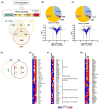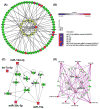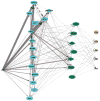Transcriptome analyses identify key cellular factors associated with HIV-1-associated neuropathogenesis in infected men
- PMID: 28005686
- PMCID: PMC5389669
- DOI: 10.1097/QAD.0000000000001379
Transcriptome analyses identify key cellular factors associated with HIV-1-associated neuropathogenesis in infected men
Abstract
Objective: HIV-1 viral proteins and host inflammatory factors have a direct role in neuronal toxicity in vitro; however, the contribution of these factors in vivo in HIV-1-associated neurocognitive disorder (HAND) is not fully understood. We applied novel Systems Biology approaches to identify specific cellular and viral factors and their related pathways that are associated with different stages of HAND.
Design: A cross-sectional study of individuals enrolled in the Multicenter AIDS Cohort Study including HIV-1-seronegative (N = 36) and HIV-1-seropositive individuals without neurocognitive symptoms (N = 16) or with mild neurocognitive disorder (MND) (N = 8) or HIV-associated dementia (HAD) (N = 16).
Methods: A systematic evaluation of global transcriptome of peripheral blood mononuclear cells (PBMCs) obtained from HIV-1-seronegative individuals and from HIV-1-positive men without neurocognitive symptoms, or MND or HAD was performed.
Results: MND and HAD were associated with specific changes in mRNA transcripts and microRNAs in PBMCs. Comparison of upstream regulators and TimePath analyses identified specific cellular factors associated with MND and HAD, whereas HIV-1 viral proteins played a greater role in HAD. In addition, expression of specific microRNAs - miR-let-7a, miR-124, miR-15a and others - were found to correlate with mRNA gene expression and may have a potential protective role in asymptomatic HIV-1-seropositive individuals by regulating cellular signal transduction pathways downstream of chemokines and cytokines.
Conclusion: These results identify signature transcriptome changes in PBMCs associated with stages of HAND and shed light on the potential contribution of host cellular factors and viral proteins in HAND development.
Figures




Similar articles
-
MicroRNA regulation and its effects on cellular transcriptome in human immunodeficiency virus-1 (HIV-1) infected individuals with distinct viral load and CD4 cell counts.BMC Infect Dis. 2013 May 30;13:250. doi: 10.1186/1471-2334-13-250. BMC Infect Dis. 2013. PMID: 23721325 Free PMC article.
-
Systems analysis of human brain gene expression: mechanisms for HIV-associated neurocognitive impairment and common pathways with Alzheimer's disease.BMC Med Genomics. 2013 Feb 13;6:4. doi: 10.1186/1755-8794-6-4. BMC Med Genomics. 2013. PMID: 23406646 Free PMC article.
-
Mechanisms of HIV Neuropathogenesis: Role of Cellular Communication Systems.Curr HIV Res. 2016;14(5):400-411. doi: 10.2174/1570162x14666160324124558. Curr HIV Res. 2016. PMID: 27009098 Free PMC article. Review.
-
Transcriptome analysis of HIV-infected peripheral blood monocytes: gene transcripts and networks associated with neurocognitive functioning.J Neuroimmunol. 2013 Dec 15;265(1-2):96-105. doi: 10.1016/j.jneuroim.2013.09.016. Epub 2013 Sep 26. J Neuroimmunol. 2013. PMID: 24094461 Free PMC article.
-
HIV-1 Induced CNS Dysfunction: Current Overview and Research Priorities.Curr HIV Res. 2016;14(5):389-399. doi: 10.2174/1570162x14666160324124940. Curr HIV Res. 2016. PMID: 27009096 Review.
Cited by
-
The Integrated Stress Response and Phosphorylated Eukaryotic Initiation Factor 2α in Neurodegeneration.J Neuropathol Exp Neurol. 2020 Feb 1;79(2):123-143. doi: 10.1093/jnen/nlz129. J Neuropathol Exp Neurol. 2020. PMID: 31913484 Free PMC article. Review.
-
Non-Human Primate Models of HIV Brain Infection and Cognitive Disorders.Viruses. 2022 Sep 9;14(9):1997. doi: 10.3390/v14091997. Viruses. 2022. PMID: 36146803 Free PMC article. Review.
-
New Potential Axes of HIV Neuropathogenesis with Relevance to Biomarkers and Treatment.Curr Top Behav Neurosci. 2021;50:3-39. doi: 10.1007/7854_2019_126. Curr Top Behav Neurosci. 2021. PMID: 32040843
-
RNA landscapes of brain tissue and brain tissue-derived extracellular vesicles in simian immunodeficiency virus (SIV) infection and SIV-related central nervous system pathology.bioRxiv [Preprint]. 2023 Apr 29:2023.04.01.535193. doi: 10.1101/2023.04.01.535193. bioRxiv. 2023. Update in: J Infect Dis. 2024 May 15;229(5):1295-1305. doi: 10.1093/infdis/jiad563. PMID: 37034720 Free PMC article. Updated. Preprint.
-
Innate immune memory in chronic HIV and HIV-associated neurocognitive disorders (HAND): potential mechanisms and clinical implications.J Neurovirol. 2024 Dec;30(5-6):451-476. doi: 10.1007/s13365-024-01239-2. Epub 2024 Dec 28. J Neurovirol. 2024. PMID: 39733092 Free PMC article. Review.
References
-
- Davis LE, Hjelle BL, Miller VE, Palmer DL, Llewellyn AL, Merlin TL, et al. Early viral brain invasion in iatrogenic human immunodeficiency virus infection. Neurology. 1992;42:1736–1739. - PubMed
Publication types
MeSH terms
Grants and funding
LinkOut - more resources
Full Text Sources
Other Literature Sources
Medical

